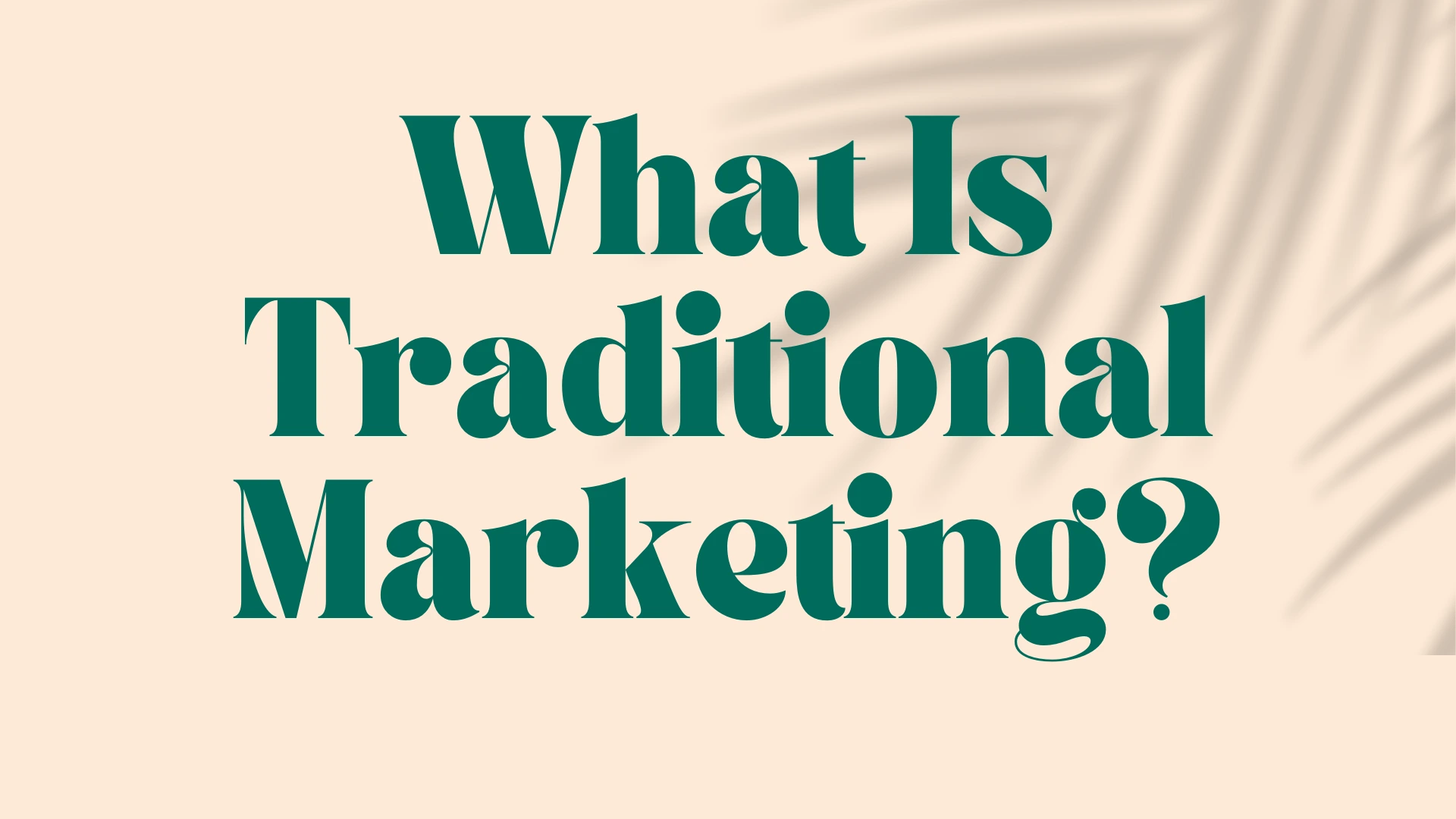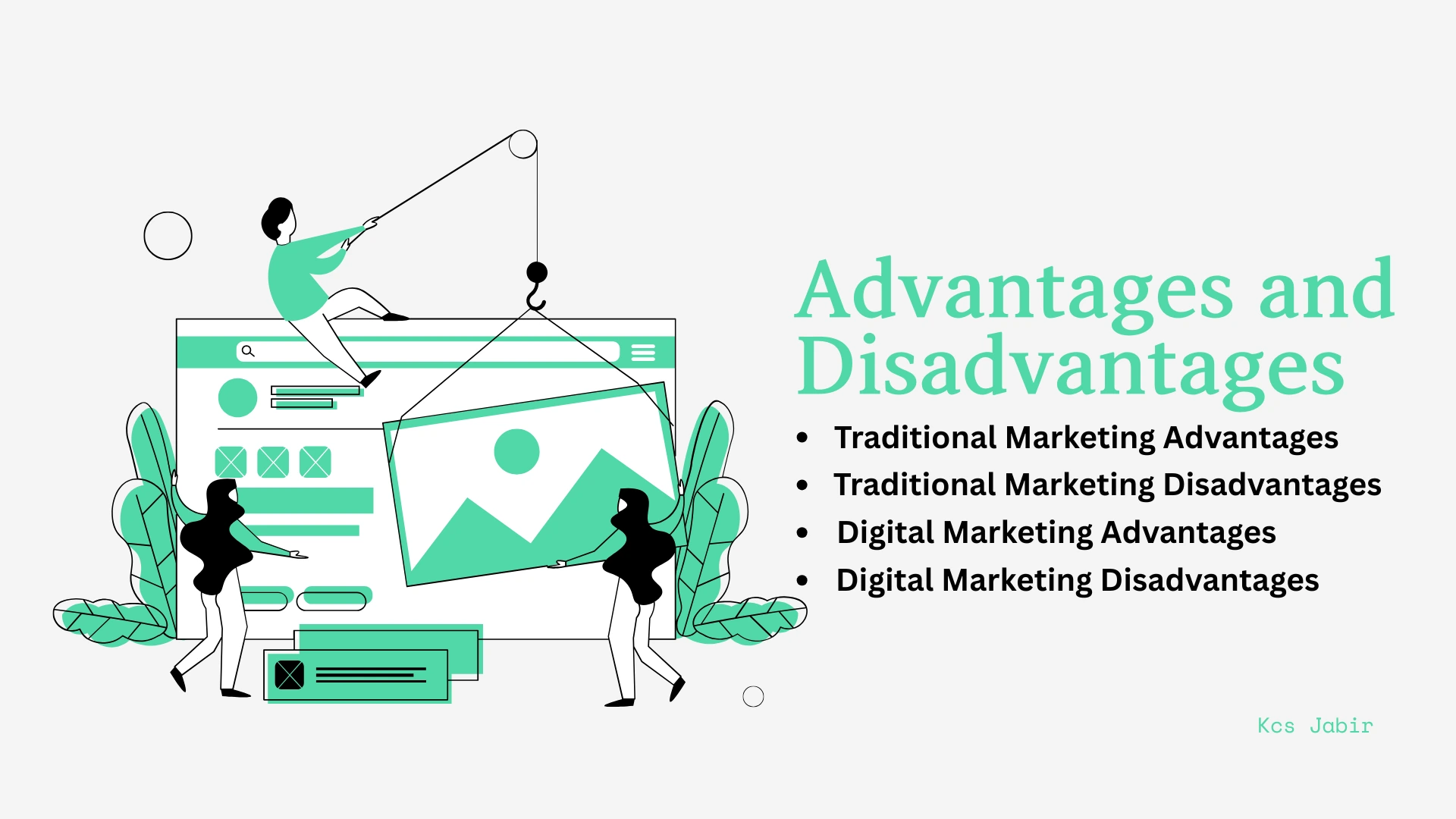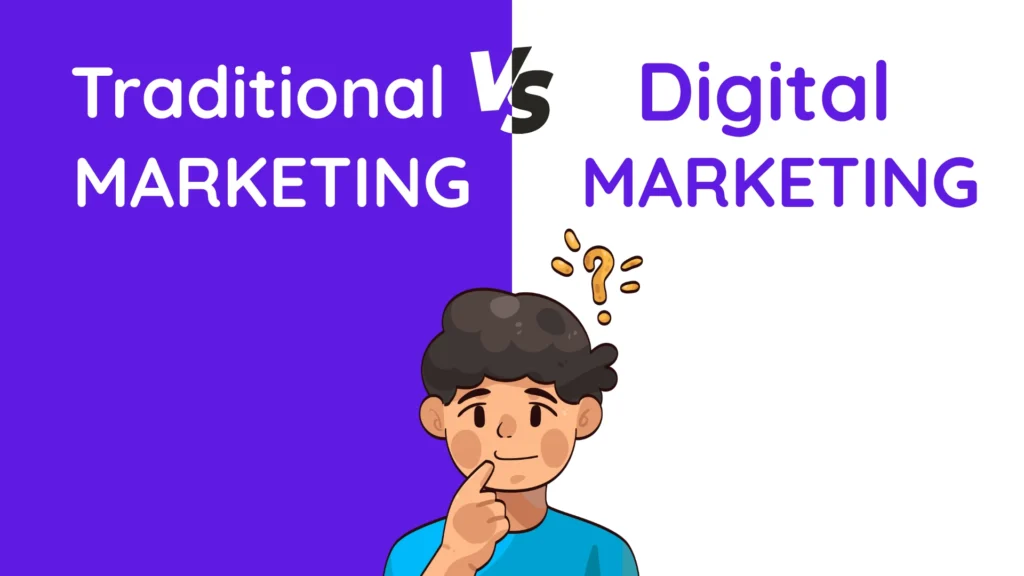Marketing has always been the bridge between businesses and their customers. Whether you’re running a small shop in your neighborhood or managing a growing brand, you need to reach people and tell them about what you offer. But here’s the thing—the way we market has changed dramatically over the years.
Not too long ago, billboards, TV commercials, and newspaper ads were the kings of marketing. Businesses spent thousands on radio spots and print campaigns, hoping to catch the attention of potential customers. That’s traditional marketing in action. But today, we live in a digital world. People are glued to their phones, scrolling through social media, watching videos, and searching for products online. This shift has given birth to digital marketing—a more targeted, measurable, and cost-effective approach.
So, what’s the real difference between traditional marketing vs digital marketing? And more importantly, which one should you choose for your business?
This question matters because your marketing strategy can make or break your business growth. Choosing the wrong approach could mean wasted money and missed opportunities. On the other hand, picking the right mix could help you reach more customers, build stronger relationships, and grow faster than your competitors.
In this blog, I’ll walk you through everything you need to know about traditional marketing vs digital marketing. We’ll look at what each one means, how they work, their advantages and disadvantages, and which one might be the best fit for your business goals. Whether you’re a small business owner, a student exploring career options, or someone curious about marketing, this guide will help you understand both worlds clearly.
By the end of this article, you’ll have a complete picture of traditional marketing vs digital marketing—and you’ll be ready to make smart decisions for your business or career. Let’s dive in.
What Is Traditional Marketing?

Traditional marketing refers to any type of marketing that doesn’t happen online. It’s the classic way businesses have promoted their products and services for decades. When discussing traditional marketing vs digital marketing, this represents the original, time-tested approach. Think of it as the “old school” method—but old doesn’t mean ineffective.
Traditional marketing includes channels like television commercials, radio ads, newspapers, magazines, billboards, flyers, brochures, and direct mail. It also covers in-person tactics like trade shows, networking events, and cold calling. These are the methods that dominated before the internet changed the traditional marketing vs digital marketing landscape forever.
For example, if you see a poster advertising a new restaurant in your city or hear a jingle on the radio about a sale at a local store, that’s traditional marketing at work. These methods rely on reaching a broad audience and creating brand awareness through repetition and visibility. This broadcast approach is one of the key differences when comparing traditional marketing vs digital marketing strategies.
The biggest strength of traditional marketing is its physical presence. A billboard on a busy highway or a full-page ad in a popular magazine can create a lasting impression. People can touch a brochure, see a TV commercial during family time, or hear a radio ad during their morning commute. This tangible quality makes traditional marketing feel more “real” to many people, which is why it still holds value in the traditional marketing vs digital marketing debate.
However, traditional marketing also has its limitations, especially when measured against digital alternatives in the traditional marketing vs digital marketing comparison. It’s usually expensive, especially for small businesses. A single TV ad can cost thousands or even millions depending on the time slot and channel.
Plus, it’s hard to measure results. How do you know exactly how many people saw your billboard and decided to visit your store? Tracking and analytics are minimal compared to digital methods.
This measurement gap is one of the most significant factors businesses consider when choosing between traditional marketing vs digital marketing approaches. A digital marketing expert in Malappuram would tell you that this lack of precise tracking is where traditional methods fall short in today’s data-driven business environment.
What Is Digital Marketing?

Digital marketing is any marketing that happens online or through digital devices. It’s the modern way of reaching customers through the internet, social media, search engines, email, and mobile apps. When comparing traditional marketing vs digital marketing, this is the newer, more tech-driven side of the equation.
Digital marketing includes strategies like search engine optimization (SEO), social media marketing, content marketing, email campaigns, pay-per-click advertising, influencer partnerships, and video marketing. Basically, if it happens on a screen and involves promoting a business, it’s digital marketing. Unlike traditional marketing that relies on physical media, digital marketing lives entirely in the online world.
For instance, when you search for “best coffee shop near me” on Google and see businesses listed at the top, that’s digital marketing through SEO and local search optimization. When you scroll through Instagram and see a sponsored post from your favorite clothing brand, that’s social media advertising. When you receive a promotional email about a weekend sale, that’s email marketing. These examples highlight how different digital marketing is from traditional marketing approaches.
As Kcs Jabir, a freelance digital marketer in Malappuram, often explains to his clients—digital marketing gives you the power to reach exactly the right people at the right time. This is one of the biggest advantages when weighing traditional marketing vs digital marketing options. You’re not just throwing your message out into the world and hoping someone notices. Instead, you can target specific audiences based on their age, location, interests, online behavior, and even what they’ve searched for recently. This precision is what sets digital marketing apart in the traditional marketing vs digital marketing comparison.
The beauty of digital marketing is its flexibility and measurability. You can start with a small budget, test different approaches, and see what works in real-time. Every click, view, and conversion can be tracked, giving you valuable data to improve your campaigns continuously. This level of insight is something traditional marketing struggles to provide, making it a crucial factor when businesses evaluate traditional marketing vs digital marketing for their growth strategy.
Key Differences Between Traditional Marketing vs Digital Marketing
Now that we understand what each approach means, let’s compare them directly across several important factors.
Reach and Targeting
Traditional marketing casts a wide net. A TV commercial might reach millions of people, but many of them may not be interested in your product. You’re paying to reach everyone, whether they’re your ideal customer or not.
Digital marketing, however, allows precise targeting. A digital marketer in Kerala can create Facebook ads that only show to women aged 25-35 who are interested in fitness and live in Kochi. This level of targeting means your marketing budget goes further because you’re reaching people who are more likely to become customers.
Cost Effectiveness
Traditional marketing typically requires a significant budget. Printing thousands of brochures, booking billboard space, or running TV ads during prime time can drain your resources quickly. Small businesses often struggle to compete with larger companies in traditional channels.
Digital marketing is generally more affordable and accessible. You can start a social media page for free, run Google ads with a budget as low as a few dollars per day, or create content marketing strategies that cost mainly time and creativity. This levels the playing field, allowing small businesses to compete effectively.
Measurement and Analytics
One of the biggest challenges with traditional marketing is measuring results. You might know that 100,000 people read the magazine where your ad appeared, but how many actually noticed your ad? How many became customers because of it? These answers are difficult to find.
Digital marketing excels in measurement. Every action can be tracked—how many people saw your ad, clicked on it, visited your website, spent time reading your content, and made a purchase. Tools like Google Analytics, Facebook Insights, and email marketing platforms provide detailed reports that help you understand what’s working and what needs improvement.
Engagement and Interaction
Traditional marketing is mostly one-way communication. You deliver your message, and the audience receives it. There’s limited opportunity for immediate interaction or feedback.
Digital marketing creates two-way conversations. Customers can comment on your social media posts, reply to your emails, leave reviews, ask questions, and share your content with their networks. This engagement builds relationships and trust, which are essential for long-term business success. A digital marketing expert in Malappuram can help businesses leverage these interactions to create loyal customer communities.
Speed and Flexibility
Traditional marketing campaigns take time to plan, create, and execute. If you want to change your billboard message or newspaper ad, you’re often stuck with what you’ve already paid for until the contract ends.
Digital marketing moves at the speed of the internet. You can launch a campaign in hours, see results within days, and make adjustments on the fly. If something isn’t working, you can pause it immediately and try a different approach. This agility is invaluable in today’s fast-paced business environment.
Advantages and Disadvantages

Traditional Marketing Advantages:
Traditional marketing has proven credibility. Many people, especially older generations, trust traditional media more than online ads. A full-page newspaper ad or a TV commercial often carries more prestige and authority.
It also creates lasting impressions. A creative billboard or memorable TV jingle can stick in people’s minds for years. Physical materials like brochures can be kept and referred to later.
Additionally, traditional marketing works well for local businesses targeting specific geographic areas. A local radio ad or community newspaper can effectively reach neighborhood customers.
Traditional Marketing Disadvantages:
The high cost is a major barrier for many businesses. Limited targeting means wasted reach on people outside your target market. Difficulty in measuring ROI makes it hard to justify the investment. And once a campaign is launched, making changes is expensive or impossible.
Digital Marketing Advantages:
Digital marketing offers cost efficiency that traditional methods can’t match. You can narrow down your audience to reach only those who match your ideal customer profile. Real-time analytics provide clear insights into campaign performance. Global reach allows even small businesses to find customers worldwide. And the ability to build relationships through engagement creates long-term value.
Digital Marketing Disadvantages:
The digital space is crowded and competitive. Ad fatigue happens when people see too many ads and start ignoring them. Technical skills are required to run effective campaigns. And some demographics, particularly older adults in certain regions, may be less accessible through digital channels.
Which One Should You Choose?
The truth is, the question isn’t really traditional marketing vs digital marketing in an either-or sense. The best approach depends on your specific situation—your business type, target audience, budget, and goals.
If you’re running a local business like a restaurant, bakery, or retail store in a specific town, combining both approaches often works best. You might use local newspaper ads and community event sponsorships (traditional) alongside social media marketing and Google My Business optimization (digital).
For businesses targeting younger, tech-savvy audiences, digital marketing should be your primary focus. These customers spend most of their time online, and that’s where you need to meet them.
If you’re a freelance digital marketer in Malappuram or anywhere else, understanding both traditional and digital marketing gives you an advantage. You can offer comprehensive strategies that blend the best of both worlds for different client needs.
For B2B companies, digital marketing through LinkedIn, content marketing, and email campaigns often delivers better results than traditional methods. For luxury brands or established corporations, traditional marketing still holds significant value for building prestige and brand image.
Kcs Jabir recommends that businesses start by clearly defining their target audience. Where do these people spend their time? What media do they consume? How do they make purchasing decisions? The answers to these questions will guide your marketing strategy more effectively than any blanket recommendation.
The Future Belongs to Integration
While we’ve been comparing traditional marketing vs digital marketing as separate approaches, the future of marketing lies in integration. The most successful businesses today don’t get trapped in the traditional marketing vs digital marketing debate—they use an integrated marketing strategy that combines the strengths of both approaches.
Understanding when to use traditional marketing vs digital marketing separately isn’t enough anymore. The real power comes from blending them together strategically. This might mean running a TV commercial that directs viewers to your social media pages or website, creating a bridge between traditional marketing vs digital marketing channels. Or using data from your digital campaigns to inform your traditional marketing messages, letting digital insights shape your offline strategies.
Another effective integration approach involves creating a physical event (traditional) and promoting it heavily through digital channels. This shows how traditional marketing vs digital marketing can work hand-in-hand rather than compete. A freelance digital marketer in Malappuram helping local businesses often recommends this hybrid approach because it maximizes reach while staying cost-effective.
The goal is creating a consistent brand message across all channels—whether someone sees your billboard, visits your website, or follows you on Instagram. When you stop thinking about traditional marketing vs digital marketing as opposing forces and start seeing them as complementary tools, you unlock new possibilities. This omnichannel approach creates multiple touchpoints with potential customers, increasing the chances they’ll remember you and choose your business.
The businesses winning today don’t ask “traditional marketing vs digital marketing—which one should I choose?” Instead, they ask “How can I use both traditional marketing and digital marketing together to create a seamless customer experience?” That’s the mindset shift that leads to breakthrough results in today’s competitive marketplace.
Conclusion
Understanding traditional marketing vs digital marketing is essential for anyone who wants to grow a business or build a career in marketing. The choice between traditional marketing vs digital marketing shapes how you communicate with customers, manage your budget, and measure success. Both approaches have unique strengths and serve different purposes in reaching and engaging customers.
Traditional marketing offers credibility, lasting impressions, and broad reach through established channels like TV, radio, print, and billboards. It works particularly well for local businesses, older demographics, and brands that want to establish authority and prestige. When evaluating traditional marketing vs digital marketing for your business, consider how your target audience consumes information.
Digital marketing provides cost-effective targeting, measurable results, and interactive engagement through online channels like social media, search engines, email, and content platforms. It levels the playing field for small businesses and allows you to focus your efforts on connecting with the exact audience who needs your product or service—something traditional methods simply can’t match to the same degree.
The reality is that the debate between traditional marketing vs digital marketing doesn’t have to be a competition. The smartest approach combines both strategies based on your specific business needs, target audience, and goals. A digital marketer in Kerala working with diverse clients understands that flexibility and integration create the best results. The question of traditional marketing vs digital marketing isn’t about picking a winner—it’s about finding the right balance.
As you move forward with your marketing efforts, remember that the tools and channels you use matter less than understanding your customers deeply. Where are they? What do they need? How can you help them? Answer these questions first, then choose the marketing methods that best connect you with your audience. Your decision on traditional marketing vs digital marketing should always be guided by where your customers spend their time and how they prefer to receive information.
Whether you lean toward traditional methods, embrace digital strategies, or blend both approaches, the key is to stay authentic, provide value, and build genuine relationships with your customers. That’s what great marketing has always been about—and what it will always be about, regardless of the channels we use. The fundamentals remain constant even as the conversation around traditional marketing vs digital marketing continues to evolve.
Start experimenting, track your results, learn from both successes and failures, and continuously adapt your approach. The marketing landscape will keep evolving, but businesses that understand both traditional marketing vs digital marketing will always have an advantage in connecting with their customers and growing sustainably. Don’t get stuck in the traditional marketing vs digital marketing debate—instead, use both as complementary tools in your overall strategy. Your success depends not on choosing one over the other, but on knowing when and how to use each approach effectively to achieve your business goals.

